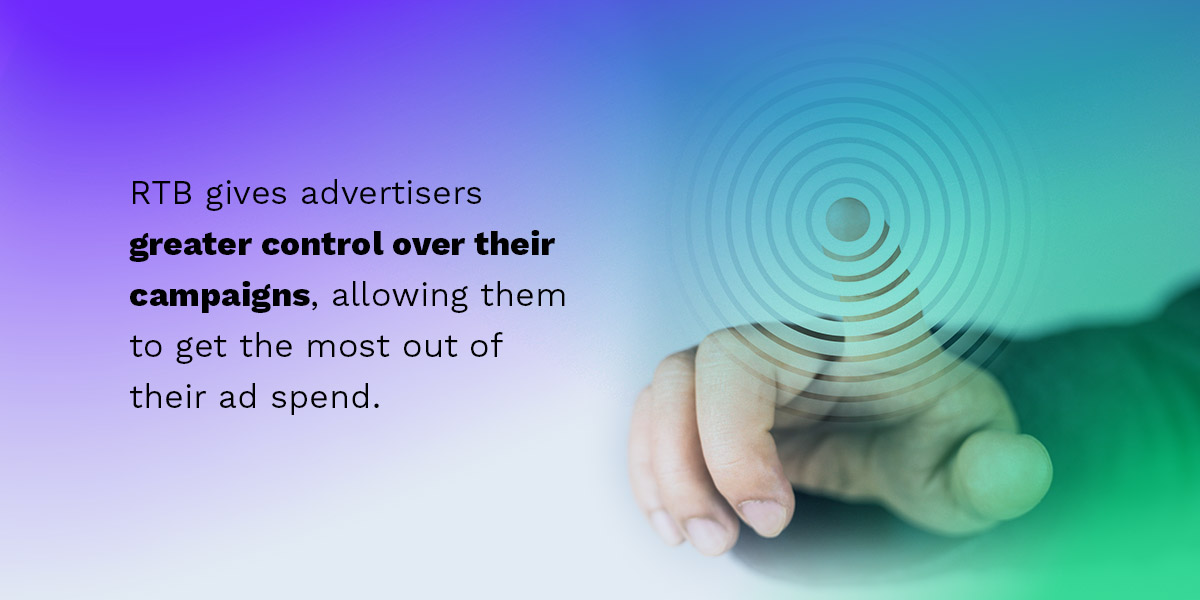Since its inception, real-time bidding (RTB) has become one of the most popular ad inventory purchasing methods. Ad platforms like Facebook Ads and Google Ads use real-time bidding.
Because the RTB process is so technical, it can be confusing even for those with extensive experience in the advertising industry. Understanding what RTB is and how it works can help you optimize your advertising strategy and benefit your bottom line.
In this guide, we’ll explain the meaning of RTB and its advantages for both advertisers and publishers.
What is real-time bidding (RTB)?
RTB advertising is an ad buying method where parties buy and sell ad impressions in real time via automated auctions that occur while a page or mobile app is loading.
These auctions take place in milliseconds, dramatically cutting the time it takes to buy ad space. RTB auctions replace traditional ad buying processes, allowing advertisers to place hundreds or even thousands of ads almost instantly.
How does RTB work?
Before we dive into how the process works, let’s go over some key terms:
- Demand-side platform (DSP): The DSP is the service advertisers use to manage their ad campaigns and buy inventory.
- Supply-side platform (SSP): The SSP is the service publishers use to make inventory available to advertisers.
- Ad exchanges: An ad exchange is a digital network that connects advertisers or DSPs with publishers or SSPs. The ad exchange is where real-time bidding takes place.
Before the bidding begins, advertisers set targeting parameters, such as maximum bid price and target audience. These parameters are essential for determining which impressions the DSP will bid on.
Multiple advertisers can bid on any impression at any moment. Whoever offers the highest bid wins the auction, and their ad appears on the page.
It’s important to note that advertisers don’t pay for each individual impression. Instead, publishers charge based on eCPM, or the cost per thousand impressions.
Here’s a simple real-time bidding example. Let’s say a user is playing a game on their phone where ads appear between levels. In this short window of time, the ad exchange receives information about the page user through first-party cookies.
Your DSP determines that the impression fits your parameters, so it places a bid in the exchange. If your offer meets the floor price, you win the auction, and your ad appears to the user. If not, the bid continues to the next buyer on the server.
Why is RTB important?
The main advantage that RTB offers to both publishers and advertisers is efficiency — as an automated process, RTB eliminates the negotiations involved in traditional ad deals and significantly reduces the time it takes to buy and sell inventory.

RTB gives advertisers greater control over their campaigns, allowing them to get the most out of their ad spend. In the past, advertisers would target specific websites. Now, advertisers can fine-tune their targeting to specific users rather than casting a wide net of anyone visiting a web page.
On the publisher side, RTB can help increase revenue by opening inventory to more buyers simultaneously. Publishers can also gain valuable insights into who is buying their inventory, which can help them determine what to charge for premium impressions to maximize revenue.
RTB vs. programmatic advertising
Programmatic advertising involves buying and selling digital inventory using automated technology. RTB is a specific type of ad inventory buying that uses automated real-time auctions to sell impressions.
Essentially, while all RTB auctions fall under the programmatic advertising umbrella, not all programmatic advertising techniques use RTB. Other types of programmatic media buying include:
- Private marketplace (PMP): A PMP auction operates similarly to an RTB auction, but publishers can restrict which advertisers get to participate.
- Preferred deals: In a preferred deal, an advertiser can get a sneak peek at a publisher’s available inventory and buy it at a fixed price before it goes up for auction.
- Programmatic direct: This type skips the auction process entirely, allowing publishers to sell directly to specific advertisers at a fixed eCPM.
RTB vs. header bidding
Header bidding is another ad buying method that uses RTB to auction off inventory. It’s sometimes also called pre-bidding or advanced bidding because it improves upon the RTB process.
Here’s how they differ. In traditional RTB, the program evaluates bid requests from advertisers sequentially — if Buyer 1 doesn’t meet the floor price, the request moves on to Buyer 2, and so on, until the floor price is met. Even if lower-ranking buyers are willing to pay more than those in the front of the queue, this model prevents them from being able to bid if the floor price is met early on.
However, in header bidding, publishers can put an impression up for auction across multiple ad exchanges simultaneously. Rather than moving through the buyers one at a time through a single ad exchange, header bidding enables all advertisers to bid simultaneously at the highest priority in the server. Whoever offers the highest bid upfront wins the auction.
As a result, header bidding allows publishers to maximize revenue by increasing competition for ad space, which raises the average bid price. If an advertiser wishes to buy high-priority impressions, they will need to pay more for it.
What are the benefits of RTB for advertisers?
RTB empowers advertisers to do more in less time by automating the media buying process.
Other benefits of RTB for advertisers include:
- Simplifying media buying: RTB eliminates the need to contact individual publishers, so advertisers don’t need to engage in long back-and-forth negotiations before purchasing digital ad space.
- Saving time: RTB enables advertisers to place hundreds or even thousands of ads within seconds. That’s exponentially faster than traditional ad placement.
- Increasing ROI: When using a DSP to access ad exchanges, advertisers can adjust their settings to home in on the most relevant inventory for them, cutting down on wasted ad impressions and maximizing conversions.
What are the drawbacks of RTB?
While RTB is a powerful tool for streamlining ad purchasing, there are some potential drawbacks advertisers should be aware of:
- Ad fraud: Scammers can use bots to trick ad networks into selling false impressions, which reduces the likelihood of your ad being seen. Using an SSP that verifies media buyers, like Emodo Access, can significantly reduce your risk.
- Brand safety: Due to the randomized nature of RTB, there is a chance your content could appear next to content that doesn’t align with your brand. Fortunately, you can reduce this risk by buying through an intelligent end-to-end ad exchange like Emodo Exchange, which connects media buyers to the right publishers for their brands.
- User privacy: RTB allows advertisers to home in on specific users, which has created concerns over the security of sensitive user data. Anonymous audience segmentation solutions like Emodo Audiences strengthen respect for user privacy without sacrificing targeting accuracy.
Taking time to set safeguards can help you avoid these issues and protect your brand.
Maximize your opportunities with Emodo
At Emodo, we strive to provide smart solutions to empower both advertisers and publishers to maximize their investments, including the use of RTB to uplevel digital advertising from underperforming programmatic technology, providing an experience that is more meaningful to consumers, impactful for brands, and profitable for publishers.
The Emodo Activate DSP for advertisers provides direct access to Emodo Exchange, our intelligent ad exchange. With Emodo Activate, advertisers do more with less, creating advertising campaigns across channels.
The Emodo Access SSP for publishers has direct access to demand from Emodo Activate and allows publishers to increase bid density to maximize competition across channels. Publishers can increase bid density to maximize competition across channels.
Make more meaningful connections with Emodo. Connect with us today to see what’s possible.
MORE LIKE THIS



